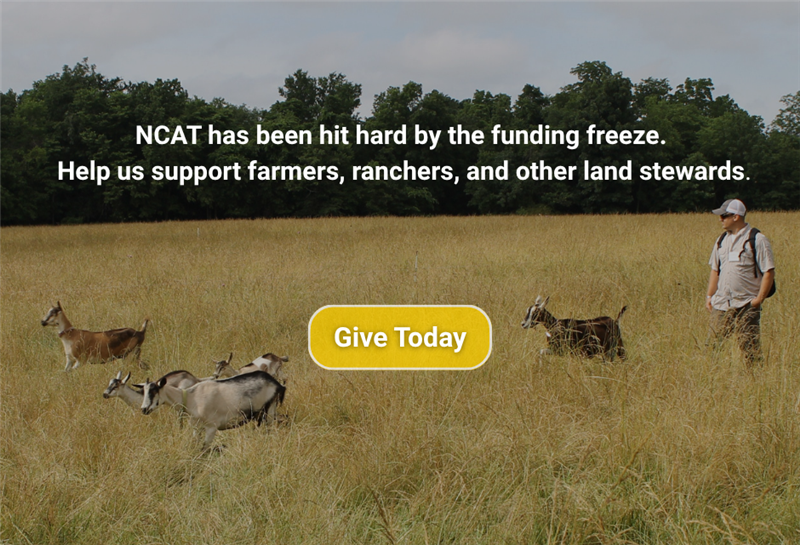Tips for Selling to Produce Distributors
NCAT Marketing Tipsheet Series
By Marisa Alcorta, Rex Dufour, and Tammy Hinman, NCAT

Earl’s Organic Produce, San Francisco.
Photo:Rex Dufour, NCAT
Produce distributors are businesses that aggregate product and resell it
in small or large quantities to their customers. Distributors may be an individual with a van or a company with a fleet of eighteen-wheelers. Distributors can purchase from individual farmers, brokers, wholesale buyers, or packing houses. Distributors sell to a range of customers, from individual restaurants to institutions such as hospitals and schools. Since local food has come into higher demand, some distributors have made the effort to focus their business on providing local produce to their customers.
For this market you can expect:
- Higher volume of product
- Lower prices per unit
Advantages
- Distributors can handle large volumes of product.
- Distributors can contract for a particular product for the whole season.
- Farm product identity could be retained in this wholesale market if the distributor focuses on local products.
Considerations
- While you can sell a larger quantity, expect a lower price per unit.
- Some distributors may not pay for 30 to 60 days. Make sure to keep organized records of money owed to you and be clear about when you want to be paid.
- Distributors have USDA standard pack and grade requirements that you will need to follow, which include clean, new boxes.
- Selling to distributors requires a well organized invoicing and recordkeeping system.
Tips for Selling to Produce Distributors
Contact the distributor to see what products they are looking for as well as volume, price, pack and grade preferences, delivery or pickup schedule, and liability insurance and GAPs (Good Agricultural Practices) requirements.
- Ensure quality by pre-cooling and careful post-harvest handling.
- Consider specialty products that may bring a higher price, such as green garlic, squash blossoms, or pea tendrils that are variations on conventional items.
Key Questions to Ask Yourself
- How do these buyers want produce packed and delivered? What quantities do they want, and how often?
- Do I have liability insurance or a GAPs plan? Do these buyers require either of these items, and how much coverage do I need to have?
Resources
The Packer is a weekly newspaper covering fruit and vegetable news, produce shipping, distribution, packing, marketing, and trends in fresh produce in North America.
Wholesale Success: A Farmers Guide to Selling, Post Harvest Handling, and Packing Produce is a 255-page manual about the wholesale produce industry, with details on building relationships, food safety, grading standards, filling orders, record keeping, and billing. The manual includes harvesting, cooling, storing, and packing information for 103 different fruits and vegetables.
AMS Fresh Fruit, Vegetable, Nut, and Specialty Crop Grade Standards lists the U.S. Agricultural Marketing Service grade (quality) standards for each fruit, vegetable and nut sold as commodities.
Community Food Security Liability & Food Safety (in English and Spanish). This short brochure summarizes some of the issues regarding food safety when selling to institutional markets. It gives the reader information on what to expect for insurance requirements and how to better protect your farm.
Como Proteger Su Negocio Agrícola y Producir Alimentos Seguros en Su Granja is a Spanish audio version of the Food Safety and Liability Insurance brochure mentioned above. On the Community Food Security Coalition website.
USDA Terminal Market Report lists current wholesale prices.
Rodale Institute Organic Price Report can be configured to show organic only or to compare organic and conventional wholesale prices at the current market rates. Prices of fruit, vegetables and grains are listed for six different wholesale terminals across the U.S.
UC Davis Small Farm Program Wholesale Market Resources explain wholesale buyers and terminal markets.
Tips for Selling to Produce Distributors
© 2012 National Center for Appropriate Technology—NCAT
By Marisa Alcorta, Rex Dufour, and Tammy Hinman, NCAT
IP431
This publication is produced by the National Center for Appropriate Technology through the ATTRA Sustainable Agriculture program, under a cooperative agreement with USDA Rural Development. This publication was also made possible in part by funding from USDA/NIFA/OASDFR. ATTRA.NCAT.ORG.
Related Publications
- New Markets for Your Crops
- Scheduling Vegetable Plantings for Continuous Harvest
- Season Extension Techniques for Market Gardeners
- Tips for Selling at Roadside Stands
- Tips for Selling to Aggregators/Grower Marketing Coops
- Tips for Selling to Institutional Markets
- Tips for Selling to Wholesale Buyers at Terminal Markets
- Tips for Selling to Produce Packing Houses
- Tips for Selling with Agritourism and “Pick-Your-Own”


